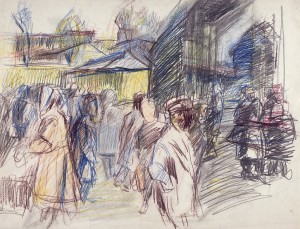Koroteev had a talent for feeling the world as the movement of life. He felt it like the physics of multidirectional flows of existence and his entire body was given over to it just as it belonged to him. And it was also as if he worked with his entire body, as if elements of dance were involved in the work of an artist and as if painting were the traces of the master’s rhythmic actions. This is why Koroteev treated the body like an instrument: he trained it, performing series of Japanese martial arts and yoga exercises in the mornings, he struck complex, balanced stances and held inverted poses. And then it is clear that in his works “feeling” the world is not a metaphor but rather an anatomical movement, a change in the body’s state of being in response to a shift in the state of the world, in the way it looks, feels and can be captured by an artist, in response to new winds in which can be heard the innermost meanings of the world, which are transferred to the canvas.
Sometimes he would don wide pants with deep pockets and go walking, either alone or with his daughter, simply down the street, to the church or to Paveletsky Market, holding his hands in his pockets, where several sheets of thick paper or bits of soft cardboard were hidden. In his right hand he had a short little pencil, he walked or stopped and drew, without taking his hands from his pockets and not drawing attention to himself, he drew, conveying an impulse directly from the subject of the image to his hand. In this way he did not allow the eye to participate in the drawing and to subject the image to the inerasable censorship of schooling. For him, these experiments were not an empty pastime: he later studied the resultant scribbles, examining and analyzing them, but of particular importance was the constant immersion in his work.
What is this work? It is the complex mechanics of tapping into the pulsations, of hearing the palpitations of the world and of growing into them; it is physically, mutually belonging to the impulses of life, their starts and the breaks in them. For this reason, each of Koroteev’s paintings contains a distinct, figurative authenticity of the moment when a person and the world open to meet one another: the landscapes he painted at Sparrow Hills after the war, during the latter half of the forties, the fifties and the early sixties, are completely literal, authentic and precise. It is difficult for a viewer to believe this when encountering the free style of his strokes for the first time. (“Free” is a very exact characterization of Koroteev’s painting.) This is likely the true realism of the second half of the twentieth century.



